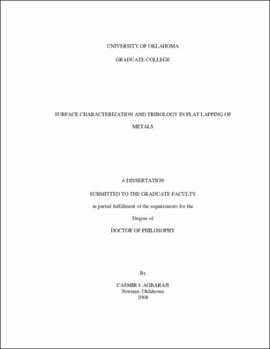| dc.contributor.advisor | Raman, Shivakumar | |
| dc.creator | Agbaraji, Casmir Ifeanyi | |
| dc.date.accessioned | 2019-04-27T21:36:56Z | |
| dc.date.available | 2019-04-27T21:36:56Z | |
| dc.date.issued | 2008 | |
| dc.identifier | 99345766202042 | |
| dc.identifier.uri | https://hdl.handle.net/11244/319166 | |
| dc.description.abstract | Lapping is a loose abrasive process employed to remove very small quantities of materials leading to a good surface finish. This research makes several investigations on the lapping process, both qualitative and quantitative. Lapping has been in existence for several decades and yet remains more of an art rather than a science. The principal objective is to create a scientific basis to the study of lapping common metals with common abrasives. The important goals are to study friction, material removal rate, roughness, surface characterization, redox chemistry, burn, and microvoids during flat lapping of aluminum 2024, 304 stainless steel, and 1018 steel. The effects of different abrasives: garnet, silicon carbide, and white aluminum oxide were studied experimentally while lapping aluminum 2024, 304 stainless steel, and 1018 steel. | |
| dc.description.abstract | In addition, the area of lapped parts, unfinished zones, and scratched zones were determined using image analysis. Although the aim of lapping is to improve surface finish, sometimes parts are rejected after lapping because of burn, friction, incomplete lapping, scratches, microvoids, and wear. Scratches may be caused by excessive load, low supply of abrasive slurry, or high friction and burn may be caused by excessive load. Uneven distribution of load occurs when the lapping table is not flat, but rather concave or convex in shape. The factors that cause burn, scratches, and incomplete lapping should be minimized. | |
| dc.description.abstract | A new method is proposed for calculation of frictional force during lapping using the current consumed in the process. The effects of different abrasives on material removal rate and surface finish on three different types of work materials were evaluated quantitatively. It was found that silicon carbide and white aluminum oxide abrasives removed more material per minute than garnet. Furthermore, from geometric and Energy Dispersive Spectroscopy (EDS) analysis obtained using a Scanning Electron Microscope (SEM), it was confirmed that some abrasives became embedded into the lapped metal substrates. No burn was observed on the lapped samples. Scratches and unfinished lapped parts were observed primarily in 304 stainless steel. There were little or no scratches found on lapped Al 2024 and 1018 steel. | |
| dc.description.abstract | Based on the net cell reaction potentials using the Nernst equation, the possible reactions during the lapping process are reactions between magnesium and its hydroxides and white aluminum oxide abrasive. Also, SiO2 from SiC abrasives oxidized Al, Mn, Mg, and Ti in Al 2024 as well as Mn in 304 stainless steel, and Al and Mn in 1018 steel. Analysis of Variance (ANOVA) was performed using Statistical Analysis Software (SASTM 9.1) in order to determine the effects of each variable. ANOVA results revealed that the main effects of abrasive types, size of abrasives, and type of work material had statistically significant influence on material removal rate and surface finish. | |
| dc.format.extent | 304 pages | |
| dc.format.medium | application.pdf | |
| dc.language | en_US | |
| dc.relation.requires | Adobe Acrobat Reader | |
| dc.subject | Grinding and polishing | |
| dc.subject | Tribology | |
| dc.subject | Abrasives | |
| dc.title | SURFACE CHARACTERIZATION AND TRIBOLOGY IN FLAT LAPPING OF METALS | |
| dc.type | text | |
| dc.type | document | |
| dc.thesis.degree | Ph.D. | |
| ou.group | College of Engineering::School of Industrial Engineering | |
